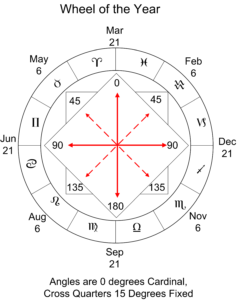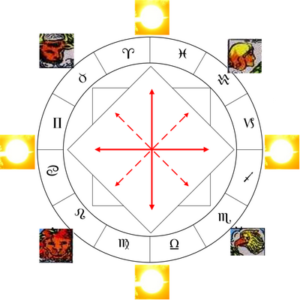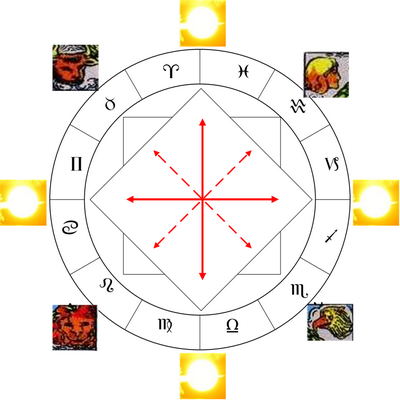The World Angles and the World Chart
In this post I want to share a train of thought I’m pursuing regarding the importance of the cardinal points as acting like world angles for a world chart. These are based on notes that I made as I was thinking this through. I will keep that order since I want to share my thought process here.
I want to make the case that what I am presenting here is not something new or modern, but goes all the way back to some of the earliest roots of our astrology.
This whole argument is based on two premises or points; everything else follows logically from these.
Point One – The four cardinal points, 0 degrees of each of the cardinal signs, are the world angles.
Modern Uranian astrology refers to these as the Cardinal Points. You will also hear them referred to as the Aries Point, but the way that is used includes all four cardinal signs. These are the four points that mark the Equinoxes and Solstices, the four seasons of our year. In Uranian astrology the Cardinal points connect us to the world at large. In that respect the cardinal points act like angles, points of action, points connecting us to the world around us. It is a similar sort of connection to the Ascendant and Midheaven axes, but more universal.
The four points are in a Harmonic 4 aspect to each other – Harmonic 4 means they are based on dividing the 360 circle into 4, giving 90 degree angles.
All angularity in astrology is based on 90 degree angles.
It is this angularity that is the reason why the cardinal ingress points are critical to astrology; they are the four marker points of the relation between the Earth as a whole and the Sun.
Point Two – the harmonic 8 midpoints between the four angles are important, forming hard aspects that trigger action with the angles.
If you divide the 360 circle in 8 you get points 45 degrees apart. Along with the Harmonic 4 series (conjunction, opposition or 1/2, square or 1/4) you get four in-between points we call semisquare (45 degrees or 1/8 the circle) and sesquiquadrate (135 degrees or 3/8). In relation to the 4 cardinal points, the 1/8 or cross points all fall at 15 degrees of the fixed signs.
You can think of these points as being the 8 phases of the Sun, parallel to the 8 phases of the Moon.
Along with being points in the zodiac they correspond to dates on the calendar where the Sun reaches those degrees of the zodiac.
The 4 cardinal points – Sun at 0 degrees cardinal – are roughly Mar 21 (0 Aries, Spring Equinox), Jun 21 (0 Cancer, Summer Solstice), Sep 21 (0 Libra, Autumnal Equinox), Dec 21 (0 Capricorn, Winter Solstice.) The dates are approximate and can vary by a day or two either side since we do not have a 360 degree calendar and our year is not exactly 360 days.
The harmonic 8 midpoints, where the Sun is at 15 degrees of the fixed signs, are roughly May 6 (15 Taurus), Aug 6 (15 Leo), Nov 6 (15 Scorpio), and Feb 6 (15 Aquarius).

If the cardinal points are the world axes then these 8 points are the days the Sun makes a harmonic 8 hard aspect to the axes; hence they should be sensitive points for the Sun.
What we see here is the wheel of the year and the 8 days at the cardinal and the cross points.
This should be starting to sound very familiar to some of my audience.
Allowing for the irregularities of our calendar, if the cross-point days are indeed halfway between the equinox and solstice points – then you have a solar based system focused on the 8 days the Sun makes a harmonic 8 aspect to the world angles.
Again, allowing for the irregularities of our calendar, this matches the pagan wheel of the year and their 8 festivals. Again, the dates of the cross points are approximate, and I think this is partly because most people who use these holidays are not fully aware of the connection between the cross-quarter days and the Sun reaching 15 degrees of the fixed signs, or of the importance of the Harmonic 8 aspects.
This system points back to a solar-based astrology time system recognizing the importance of these harmonic 8 aspects, and of the cardinal points as world angles.
Guardians of the Quarters
We have a further possible piece of evidence pointing to the importance of these cross-quarter points at 15 degrees of the 4 fixed signs. I am less confident in this than I am in the rest of my argument, but I find this very suggestive so I am sharing it here.
If we were to find major markers at the center of the fixed signs, that would reinforce them as important points. As it turns out, we do have cross-quarter markers – the four royal stars, which in an earlier time period were at the middle of the four fixed signs. We have Aldebaran for Taurus, Regulus for Leo, Antares for Scorpio, Fomalhaut for Aquarius. Because of precession these stars are no longer at those zodiac locations, but I maintain they were chosen because of their location at the center of the fixed signs. This suggests that these points aren’t important because of the royal stars; rather, these particular stars are important because they marked the Harmonic 8 cross points at 15 degrees of the fixed signs.
 The royal stars act like guardians of the cross quarters. Their location at the center of the fixed signs is precisely what made them royal stars. They are important enough that we associate them with the four guardian kerubs of the fixed signs, the Bull (Taurus), the Lion (Leo), the Eagle (Scorpio), the Man (Aquarius). You find that symbolism of the four guardian cherubim with the same four symbols in the book of Ezekiel. Those four made their way into Christian symbolism as standing for the four Evangelists and the four Gospels. Four cherubim, four angels, four guardians, four evangelists – the guardians of the four corners of the world.
The royal stars act like guardians of the cross quarters. Their location at the center of the fixed signs is precisely what made them royal stars. They are important enough that we associate them with the four guardian kerubs of the fixed signs, the Bull (Taurus), the Lion (Leo), the Eagle (Scorpio), the Man (Aquarius). You find that symbolism of the four guardian cherubim with the same four symbols in the book of Ezekiel. Those four made their way into Christian symbolism as standing for the four Evangelists and the four Gospels. Four cherubim, four angels, four guardians, four evangelists – the guardians of the four corners of the world.
And – they are always at the corners.
As I said, I am not completely confident in my argument here – I do not have the necessary background in history or in sidereal astrology. In other literature I have seen, the four royal stars were said to have marked the start of the seasons at an earlier time. That does not explain why these points are at the middle of fixed signs, and why everything I have seen about the Ingresses refers to their starting at the beginning of the cardinal signs, and the zodiac is consistently said to start at 0 Aries.
The symbolism here is very interesting and suggestive, and it is worth meditating on the four corners or guardians being in fixed signs, like pillars supporting the whole structure. The four angles are cardinal and dynamic, the four cross-quarters are stable.
Early Eight House System
There is a further piece of evidence in our tradition that supports this harmonic 8 structure. In Firmicus Maternus, the book Mathesis, there are two different schemes for the topics of the houses – and one of the schemes of house meanings has only eight houses. The house boundaries would have made hard harmonic 8 aspects to the angles and hence would be sensitive points. The eight house system would correspond to the eight phases of the Sun.
We have a harmonic 8 solar based system here with the cardinal points as the world angles and the cross-quarter points as equally important points marking phases or transitions in the cycle of the year.
I think I have a pretty strong case here for viewing the four 0 degrees cardinal points as the world axes, and for the 15 degrees fixed as being critical cross points using harmonic 8 aspects.
Astrology Ingress World Chart
As a working astrologer where am I going with this?
I maintain that this system gives us a good justification for using the four Ingress dates, with the cardinal points as the angles or axes, to examine as an ingress chart that applies to the entire world.
The purpose of this entire essay is to show that using an Ingress chart with the cardinal angles has some strong symbolic roots in our astrology tradition – actually in our larger western sacred tradition.
Alfred Witte, the inventor of Uranian astrology, may be a more amazing genius in rediscovering astrology tradition then we have yet fully recognized.
What About Houses?
We have a couple of different ways of addressing the house problem, what sign we put on what house angle.
Most Western astrology use Aries as the main ingress for the year. So one way to approach this would be to put 0 Aries as the start of the first house. If you look at quarterly ingresses you could put each of the cardinal signs in turn on the Ascendant. This has the elegance of letting the Sun define this important angle.
Another option would be to put 0 degree Aries at the Midheaven, the culmination of the chart. As an Aries Ingress house layout, this would be for the moment the Lord the Sun in Aries is culminating at the top of the sky. Again, this has the elegance of letting the Sun define this important angle, and there is an appropriateness to letting the Sun be culminating.
Uranian astrology has another approach to this – they use the Capricorn Ingress as the logical start of the year. This makes sense if you think of the 8 solar phases as being parallel to the 8 lunar phases, where the Capricorn ingress would correspond to the new Moon. Uranian uses what it calls Earth houses, which puts 0 Capricorn at the bottom of the chart at the cusp of the 4th house since at the dead of winter it is the point furthest from the Sun. The rising sign would be Libra, and that puts 0 Cancer, the point of the Summer Solstice, as the culmination of the chart at the Midheaven. It’s an appealing system; I have worked with it and it yields interesting results.
Summing up the different approaches:
1) Use the Ingress sign as the cusp of the first house and Ascendant of the world chart.
2) Use the Ingress sign as the cusp of the tenth house and Midheaven of the world chart.
3) Use the Uranian Earth house system putting 0 Capricorn at the cusp of the fourth house, the IC of the world chart.
Which house system is best to use here with the world angles? I think that is a question that will take quite a bit of research and experimentation to begin to answer. I would not be surprised if multiple house systems work and each highlight different things. I have done some preliminary work with the Uranian Earth House system and I think that one is definitely worth pursuing further, but all three choices have their own logic and beauty.
Ingress Charts without Houses
There is also the Uranian approach of using the 90 degree dial for chart analysis. That does not use houses at all, but relies on hard aspects, midpoint configurations, and what it calls planetary pictures that are the modern equivalent of the Lots. If you know what you’re doing with the dial you can get a LOT (pun intended) of good information out of a chart that way without any need to refer to houses at all.
[As a technical note, I will be doing more exploration of using midpoint and dial techniques to analyze ingress and other charts in future posts.If learning that is of interest to you please let me know, either in a comment to this post or by contacting me. I may do future videos and webinars on that topic.]
Regardless of which approach, I think we have good reason to explore using the Ingress charts, with the Cardinal points as the world angles, as a way to have a chart that applies to the entire world. There will always be the need for localized Ingress charts for specific locations, but I think now more than ever we have need for a way to consider the world as one.


Hi Charlie,
I would be interested in seeing how you apply this. Thank you!
Always interested in your work, even if I am not particularly interested in integrating this into consultations with my clients.